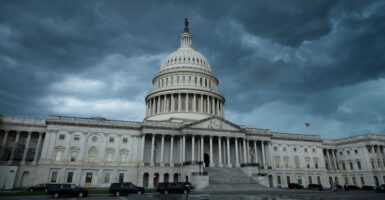The current version of the federal debt ceiling deal does a bad job addressing student debt, despite the fact that the Biden administration’s student debt cancellation schemes will cost the taxpayer hundreds of billions of dollars. While the yearslong student loan “pause” will finally end, the biggest schemes are left untouched.
The debt ceiling deal is therefore a model of fiscal irresponsibility and missed opportunities in this area.
The only good thing in the bill is an end to the unlawful series of pauses of student loan repayment. Since 2020, borrowers of federal student loans have had to pay zero on their loans, no interest has accrued, and the U.S. Department of Education has counted these zero-dollar “payments” toward the number of monthly payments required for other debt cancellation programs. By the end of August 2023, no more extensions of this scheme will be allowed.
This provision of the bill is only a short-term win, however. The provision seems to codify the legality of the pause, despite the possibility that the legal authority for the pause (the HEROES Act) does not extend indiscriminately to the entire nation (or even the world, considering borrowers who have been overseas).
Codifying the current pause suggests that if the president declares a new “emergency,” then the Department of Education is allowed to start a whole new series of pauses.
Why is the “pause” provision even in this bill, since the Department of Education has already promised that the pauses would end? The problem is that the agency is completely untrustworthy on this point. The agency has promised to end the series of pauses before, only to violate its promises time after time and add new extensions. Even now, the agency appears to be looking for some rationale to delay full resumption of repayment obligations.
Much worse than what’s in the bill is what’s not. The deal has complete silence on the Department of Education’s loan cancellation and income-based repayment schemes, each of which will cost taxpayers hundreds of billions of dollars and go further to socialize higher education.
The loan cancellation scheme, giving away up to $20,000 per borrower, would cost around $300 billion over 10 years if the Supreme Court lets it through. It’s probably good to let the Supreme Court extend the Major Questions Doctrine (which prevents federal agencies from abusing their authority in order to make major changes to American life without congressional authorization) and further curtail the administrative state, rather than to use this bill to end the loan cancellation scheme—but we don’t know what the Supreme Court will decide, so this bill leaves loan cancellation as a potentially expensive risk.
Meanwhile, changes to income-based repayment, which alters the monthly payment amount on the basis of the borrower’s income, will essentially make college free for a large proportion of students. As Lindsey Burke, director of the Center for Education Policy at The Heritage Foundation, and Preston Cooper, a senior fellow at the Foundation for Research on Equal Opportunity, write:
The rule would increase the amount of income exempt from calculating student loan payments from 150 percent to 225 percent of the federal poverty line. That’s about $30,600, which for individuals aged 22-31, puts them in the 65th percentile for earnings—hardly something that should qualify them to make $0 monthly payments, as the rule would. And for many borrowers, the regulation would also reduce from 20 to just 10 years the amount of time before any remaining debt is fully ‘forgiven’ by taxpayers.
The income-based repayment changes would also include a 50% cut in the monthly payment amount from 10% to just 5% of discretionary income.
All told, the Department of Education claims that the income-based repayment changes will cost only $138 billion over 10 years. But with such extremely generous terms, a raging torrent of alumni will switch to income-based repayment to get free or almost free college. The real 10-year cost is hard to estimate but could reach a trillion dollars.
With this level of spending on the table, it would have made sense to address it in the debt ceiling bill. But negotiators ended up taking any limit to this spending off the table. That makes the debt deal almost entirely blind to America’s fiscal problem of nearly $2 trillion in student debt and a trillion of it being cancelled.
Have an opinion about this article? To sound off, please email letters@DailySignal.com and we’ll consider publishing your edited remarks in our regular “We Hear You” feature. Remember to include the url or headline of the article plus your name and town and/or state.

























